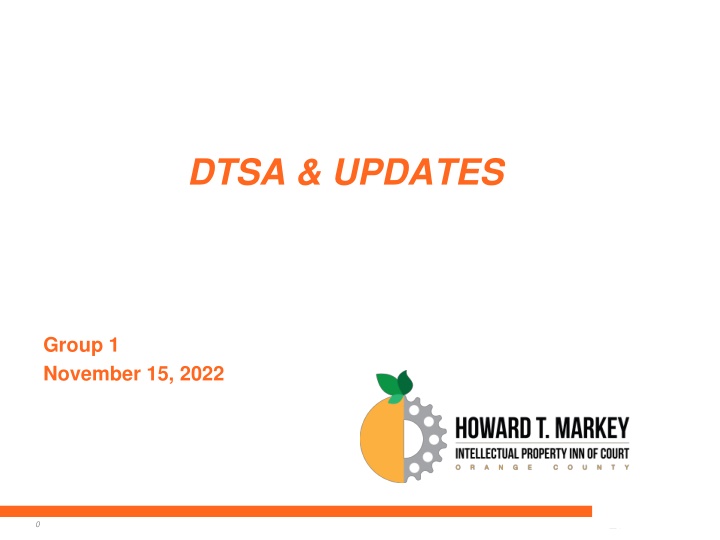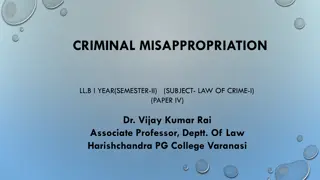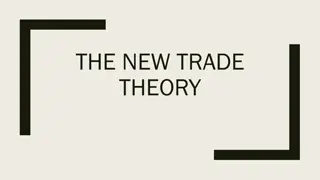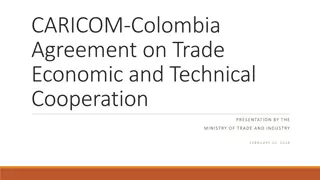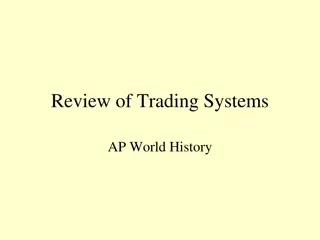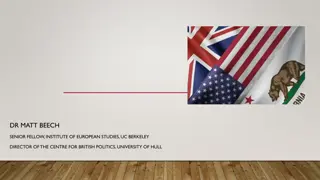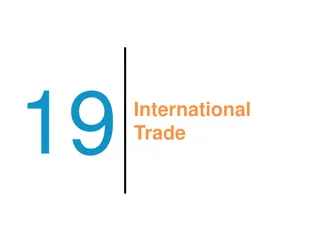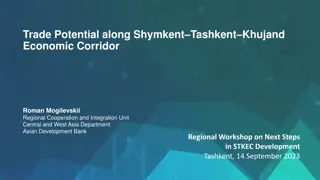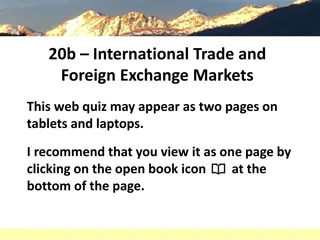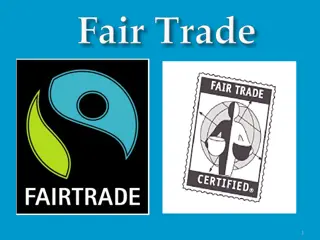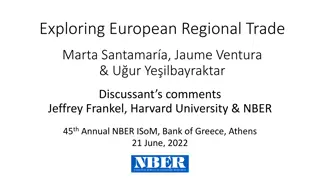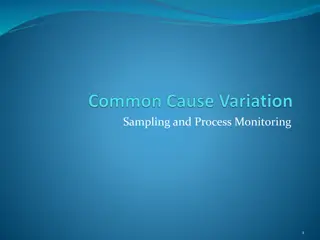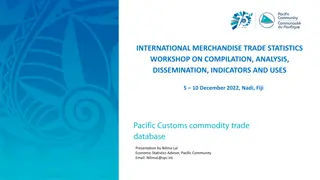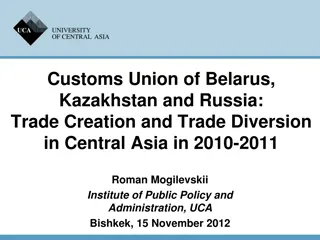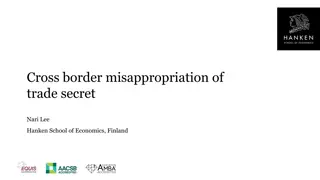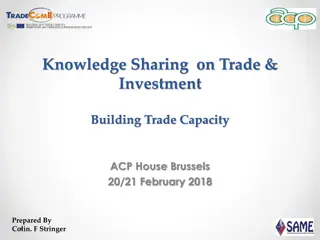Federal Cause of Action and Trade Secret Misappropriation
key aspects of the Defend Trade Secrets Act (DTSA) including federal jurisdiction, trade secret definitions, and misappropriation scenarios. Learn about the legal framework governing trade secrets at the federal level and the remedies available to protect proprietary information.
Download Presentation

Please find below an Image/Link to download the presentation.
The content on the website is provided AS IS for your information and personal use only. It may not be sold, licensed, or shared on other websites without obtaining consent from the author.If you encounter any issues during the download, it is possible that the publisher has removed the file from their server.
You are allowed to download the files provided on this website for personal or commercial use, subject to the condition that they are used lawfully. All files are the property of their respective owners.
The content on the website is provided AS IS for your information and personal use only. It may not be sold, licensed, or shared on other websites without obtaining consent from the author.
E N D
Presentation Transcript
DTSA & UPDATES Group 1 November 15, 2022 0
PRE-DTSA TRADE SECRET MISAPPROPRIATION Federal Court: Diversity jurisdiction; or independent federal cause of action State Court: Trade Secret differs from state to state Different statutes of limitations Different remedies 1
DTSA: FEDERAL CAUSE OF ACTION 18 U.S.C. 1836 An owner of a trade secret that is misappropriated may bring a civil action under this subsection if the trade secret is related to a product or service used in, or intended for use in, interstate or foreign commerce. 18 U.S.C. 1836(b)(1). 2
DTSA: TRADE SECRET [A]ll forms and types of financial, business, scientific, technical, economic, or engineering information, including patterns, plans, compilations, program devices, formulas, designs, prototypes, methods, techniques, processes, procedures, programs, or codes, whether tangible or intangible, and whether or how stored, compiled, or memorialized physically, electronically, graphically, photographically, or in writing if (A) the owner thereof has taken reasonable measures to keep such information secret; and (B) the information derives independent economic value, actual or potential, from not being generally known to, and not being readily ascertainable through proper means by, another person who can obtain economic value from the disclosure or use of the information. 18 U.S.C. 1839(3). 3
DTSA: MISAPPROPRIATION (A) acquisition of a trade secret of another by a person who knows or has reason to know that the trade secret was acquired by improper means; or (B)disclosure or use of a trade secret of another without express or implied consent by a person who (i)Used improper means to acquire knowledge of the trade secret; (ii)at the time of disclosure or use, knew or had reason to know that the knowledge of the trade secret was (I)derived from or through a person who had used improper means to acquire the trade secret; (II)acquired under circumstances giving rise to a duty to maintain the secrecy of the trade secret or limit the use of the trade secret; or (III)derived from or through a person who owed a duty to the person seeking relief to maintain the secrecy of the trade secret or limit the use of the trade secret; or (iii)before a material change of the position of the person, knew or had reason to know that (I) the trade secret was a trade secret; and (II) knowledge of the trade secret had been acquired by accident or mistake. 18 U.S.C. 1839(5). 4
DTSA: PRESERVING CONFIDENTIALITY [A] court may not authorize or direct the disclosure of any information the owner asserts to be a Trade Secret unless the court allows the owner the opportunity to file a submission under seal that describes the interest of the owner in keeping the information confidential. 18 U.S.C. 1835(b). 5
DTSA: STATUTE OF LIMITATIONS Three-year statute of limitations No later than 3 years after the date on which the misappropriation is discovered or by the exercise of reasonable diligence should have been discovered . [C]ontinuing misappropriation constitutes a single claim of misappropriation. 18 U.S.C. 1836(d). Applies to misappropriation that occurred: after DTSA was enacted on May 11, 2016; or before DTSA enacted and continued after DTSA took effect. Arms v. Unified Weapon Sys., 2016 U.S. Dist. LEXIS 132201, *17 19 (M.D. Fla. Sep. 27, 2016) 6
DTSA: EX PARTE CIVIL SEIZURE Ex parte seizure mechanism Based on an affidavit or verified complaint the court may, upon ex parte application but only in extraordinary circumstances, issue an order providing for the seizure of property necessary to prevent the propagation or dissemination of the trade secret that is the subject of the action.18 U.S.C. 1836(b)(2)(A)(i). preventative tool employed prior to finding of misappropriation following issuance of seizure order, court holds a seizure hearing where party that obtained the seizure order has the burden to prove the facts underlying the order. Failure to meet the burden results in dissolution or modification of order, Alternative seizure under Fed. R. Civ. P. 65 Seizure request as part of TRO or preliminary injunction 7
DTSA: OTHER REMEDIES Following finding of misappropriation of a trade secret, the court may grant an injunction: to prevent any actual or threatened misappropriation provided that the injunction does not: prevent a person from entering into an employment relationship conflict with applicable State law prohibiting restraints on practice of a lawful profession, trade or business. 18 U.S.C. 1836(b)(3)(A)(i). Where appropriate, an injunction may require affirmative actions to protect the trade secret. 18 U.S.C. 1836(b)(3)(A)(ii). In exceptional circumstances that render an injunction inequitable, the court may condition future use of the trade secret upon payment of a reasonable royalty. 18 U.S.C. 1836(b)(3)(A)(iii). 8
DTSA: OTHER NOTABLE PROVISIONS Inevitable Disclosure Doctrine unavailable under DTSA Can still allege pursuant to state common law where allowed Whistleblower Provision & Notice Provision To be awarded punitive damages and attorney s fees, employer must advise employees of of whistleblower immunity in employment contract or agreement. 18 U.S.C. 1833(b)(3). Overseas/Extraterritorial Application Employers may use DTSA where theft occurred outside the United States. 18 U.S.C. 1837. 9
DTSA: OTHER REMEDIES Following finding of misappropriation of a trade secret, the court may award: Damages for actual loss and unjust enrichment. 18 U.S.C. 1836(b)(3)(B). Exemplary damages not more than double amount already awarded where trade secret is willfully and maliciously misappropriated. 18 U.S.C. 1836(b)(3)(C). Reasonable attorney s fees where the misappropriation or claim of misappropriation was in bad faith, or where a party makes or opposes a motion to terminate an injunction in bad faith, or where the trade secret was willfully and maliciously misappropriated. 18 U.S.C. 1836(b)(3)(D). 10
Federal DTSA Filings Have Remained Consistent Since 2016 2016: 476* (Partial Year) 2017: 902 2018: 982 2019: 1018 2020: 1008 2021: 959 2022: 940* (Projected) 11
States With The Most Filings (All Districts In Each State) 12
Tracks Population (No Hot Spots) New York 491 Illinois 349 Pennsylvania 351 California 827 New Jersey 205 Florida 439 Texas 521 13
C.D. Cal. and N.D. Cal. C.D. Cal. 2016: 36 2017: 50 2018: 58 2019: 56 2020: 64 2021: 51 2022: 44* (Projected) N.D. Cal. 2016: 31 2017: 43 2018: 43 2019: 45 2020: 40 2021: 79 2022: 38* (Projected) 14
Additional Statistics 121 DTSA cases have gone to trial 15
Additional Statistics 121 DTSA cases have gone to trial Plaintiff prevailed 60 times 16
Additional Statistics 121 DTSA cases have gone to trial Plaintiff prevailed 60 times Ex parte seizure applications filed only 20 times 17
Additional Statistics 121 DTSA cases have gone to trial Plaintiff prevailed 60 times Ex parte seizure applications filed only 20 times Seizures granted 8 times Mission Capital Advisors v. Romaka - S.D.N.Y. 16-cv-5878Z (2016) AVX Corp. v. Kim, E.D. Tex. 6:17-00624-MGL (2017) Blue Star Land Services v. Coleman - W.D. Okla. CIV-17-931-C (2017) Axis Steel Detailing v. Prilex Detailing - D. Utah. 2:17 cv 00428 (2017) Solar Connect v. Endicott - D. Utah 17-cv-1235 (2017) Ruby Slipper Caf v. Belou - E.D. La. 18-1548 (2018) Thoroughbred Ventures LLC v. Disman - E.D. Tex. 4:18-CV-00318 (2018) Shumway v. Wright - D.Utah 19-cv-00058 (2019) 18
Additional Statistics 121 DTSA cases have gone to trial Plaintiff prevailed 60 times Ex parte seizure applications filed only 20 times Seizures granted 8 times Mission Capital Advisors v. Romaka - S.D.N.Y. 16-cv-5878Z (2016) AVX Corp. v. Kim, E.D. Tex. 6:17-00624-MGL (2017) Blue Star Land Services v. Coleman - W.D. Okla. CIV-17-931-C (2017) Axis Steel Detailing v. Prilex Detailing - D. Utah. 2:17 cv 00428 (2017) Solar Connect v. Endicott - D. Utah 17-cv-1235 (2017) Ruby Slipper Caf v. Belou - E.D. La. 18-1548 (2018) Thoroughbred Ventures LLC v. Disman - E.D. Tex. 4:18-CV-00318 (2018) Shumway v. Wright - D.Utah 19-cv-00058 (2019) Traditional TROs/PIs appear to still be favored 19
Identification of Trade Secrets Timing of Identification The UTSA and DTSA do not include provisions that explicitly govern the timing of identification Litigation Stage Complaint Before discovery commences Written discovery CA and MA: before the onset of discovery, after a protective order has been entered 20
Identification of Trade Secrets Pre-discovery identification: Minimize fishing expeditions for trade secrets Prevents P from molding trade secrets based on discovery Cannot determine relevance without identification D cannot prepare defense without identification Post-discovery identification: Broad right to discovery under FRCP P cannot know which particular trade secrets were misappropriated without visibility into D s activity 21
Identification of Trade Secrets Scope of Identification Reasonable particularity (CA state) Sufficient to (a) put a defendant on notice of the nature of the plaintiff s claims and (b) enable the defendant to determine the relevancy of any requested discovery. Adequate specificity to inform the defendants what is alleged to have been misappropriated. 22
Identification of Trade Secrets Sufficient identification Specific documents; database; excerpts from public material Insufficient identification List of categories; technology to... Level of particularity may depend on the type of trade secrets Highly technical trade secrets or those in specialized fields may require heightened particularity Amendments: showing of good cause 23
DTSA - Time period for claims DTSA May 11, 2016 TSMA* May 11, 2015 * TSMA = Trade Secret Misappropriation 24
DTSA - Time period for claims May 11, 2016 LAWSUIT May 12, 2020 TSMA*/TSMAD** May 11, 2017 * TSMA = Trade Secret Misappropriation ** TSMAD = Trade Secret Misappropriation Discovery 25
DTSA - Time period for claims May 11, 2016 TSMA*/ TSMAD** Disclosure: June 1, 2016 TSMA* / TSMAD** Acquisition: May 11, 2015 LAWSUIT May 12, 2018 * TSMA = Trade Secret Misappropriation ** TSMAD = Trade Secret Misappropriation Discovery See, e.g., Arms v. Unified Weapon Sys., 2016 U.S. Dist. LEXIS 132201, *17 19 (M.D. Fla. Sep. 27, 2016) 26
DTSA - Time period for claims May 11, 2016 TSMA*/ TSMAD** Use: Dec. 30, 2016 TSMA* / TSMAD** File Patent Application: May 11, 2012 LAWSUIT May 12, 2017 * TSMA = Trade Secret Misappropriation ** TSMAD = Trade Secret Misappropriation Discovery See, e.g., Attia v. Google, LLC, No. 19-15771 (9th Cir. 2020) 27
DTSA - Time period for claims May 11, 2016 TSMAD** Nov. 30, 2019 TSMA* Continuing Use: May 11, 2015 thru Dec. 30, 2017 * TSMA = Trade Secret Misappropriation ** TSMAD = Trade Secret Misappropriation Discovery See, e.g., Attia v. Google, LLC, No. 19-15771 (9th Cir. 2020) 28
Ex Parte Seizure Requirements 18 U.S.C. 1836(b)(2) Application extraordinary circumstances Requirements for issuing order Rule 65 order or other equitable relief is inadequate Immediate irreparable injury would occur if seizure not ordered Balance of harms Likelihood of showing: Information is trade secret Person against whom seizure is sought has misappropriated or conspired to misappropriate trade secret Person whom against seizure is sought has: Trade secret Any property to be seized Particularity of application Person against whom seizure is sought would destroy/move/hide materials if given notice Applicant has not publicized requested seizure 29
Courts Emphasize Extraordinary Circumstances Seizure is necessary to prevent propagation or dissemination of the trade secret Inadequacy of other Equitable Relief FRCP Rule 65 Order 30
Commonalities in Cases where Order was Granted Inadequacy of other forms of equitable relief High likelihood of transmission of information Thoroughbred Ventures, LLC v. Disman, No. 4:18-CV-00318, 2018 WL 8786664 (E.D. Tex. May 1, 2018) Likelihood defendants would not comply with court order Mission Cap. Advisors LLC v. Romaka, No. 16 CIV. 5878 (LLS), 2016 WL 11517104 (S.D.N.Y. July 29, 2016) Duplicitous or dishonest behavior of defendants Defendants possessed specialized skills & high likelihood evidence would be destroyed Axis Steel Detailing, Inc. v. Prilex Detailing LLC, No. 2:17-CV-00428- JNP, 2017 WL 8947964 (D. Utah June 29, 2017) 31
SAMPLE ORDER Mission Cap. Advisors LLC v. Romaka Marshal to conduct seizure Shall be conducted discreetly Storage medium to be turned over the Court Seizure hearing to be held Storage will be secured from physical and internet access until hearing Plaintiff cannot publicize the seizure Plaintiff must pay applicable fees Fee to Marshal Fee for neutral technical report Defendant restrained from specific conduct Plaintiff shall receive copy of Order 32
Commonalities in Cases where Order was Not Granted No extraordinary circumstances to warrant Ex Parte Seizure Other forms of equitable relief (Preliminary Injunction) sufficient No showing of irreparable harm absent an injunction Standard for preliminary Injunction not met Threshold for Ex Parte Seizure not met 33
Final Takeaways Extraordinary circumstances is key to courts granting Ex Parte Seizure Lack of uniformity across jurisdictions whether courts find extraordinary circumstances Courts have found 18 U.S.C. 1836(b)(2)(IV)(BB) does not indicate a cause of action for conspiracy to misappropriate trade secrets under DTSA Conspiracy does form a basis for seeking Ex Parte Seizure DecisionQ Corp. v. GigM Techs., LLC., No. 1:17-CV- 00232, 2017 WL 11504624 (E.D. Va. Aug. 9, 2017) 34
Risk a Departing Employee Faces Do you have anything that could be considered Trade Secret? Does your current job so closely resemble your old job that it would be impossible to work in that job without disclosing confidential information? 35
Inevitable Incapable of being avoided or evaded An Inevitable Outcome The inevitable disclosure doctrine allows a plaintiff to prove a claim of trade secret misappropriation by demonstrating that defendant s new employment will inevitably lead him to rely on the plaintiff s trade secrets. PepsiCo, Inc. v. Redmond, 54 F.3d 1262, 1269 (7th Cir. 1995). 37
The doctrine is not based on the former employee physically taking anything when leaving an employer, e.g. stealing a customer list or proprietary formula. it relies on the idea that the former employee s knowledge of trade secret gained over the course of his or her employment will inevitably lead to improper disclosure or use when later employed by a competitor or other entity in a position to exploit the trade secrets. PepsiCo, Inc. v. Redmond, 54 F.3d at 270. 38
Trade Secret Misappropriation A claim for trade secret misappropriation under the Title 18 U.S.C. 1836 and California Civil Code 3426, a plaintiff must [prove] that: (1) the plaintiff owned a trade secret; (2) the defendant misappropriated the trade secret; and (3) the defendant's actions damaged the plaintiff. Cisco Sys., Inc. v. Chung, 462 F. Supp. 3d 1024, 1046 (N.D. Cal. 2020). 39
Preemption The DTSA allows for Remedies that do not otherwise conflict with an applicable State law prohibiting restraints on the practice of a lawful profession, trade, or business; 18 1836(b)(3) 40
Seventeen states appear to have adopted the inevitable disclosure doctrine in one form or another under their respective state trade secrets laws Such as Illinois, See Packaging Corp. of Am., Inc. v. Croner, where a court in Illinois found that [t]he DTSA allows courts to grant injunctions in certain circumstances for threatened misappropriation. No. 19-CV-03286, 2020 WL 43011 (N.D. Ill. Jan. 3, 2020). Five states appear to have rejected the doctrine . . . such as California. See Kinship Partners, Inc. v. Embark Veterinary, Inc., 2022 WL 72123 (D. Or. Jan. 3, 2022). (California, Colorado, Louisiana, Maryland, and Virginia Reject) (and Oregon now after this case) 41
Arguments against the inevitable disclosure doctrine under the DTSA relies on the prohibition in the statute against injunctions that prevent a person from entering into an employment relationship and requirement that any employment restraints be supported by evidence of threatened misappropriation and not merely on the information the person knows. 18 U.S.C. 1836(b)(3)(A)(i)(I). The inevitable disclosure doctrine requires a court to recognize and enforce a de facto noncompetition agreement to which the former employee is bound, even where no express agreement exists . Kinship Partners, Inc. v. Embark Veterinary, Inc., 2022 WL 72123 (D. Or. Jan. 3, 2022). 42
Presumption Against Extraterritoriality "Absent clearly expressed congressional intent to the contrary, federal laws will be construed to have only domestic application." RJB Nabisco, Inc. v. European Community, 579 U.S. 325, 335 (2016) 43
DTSA 18 U.S.C. 1836 of the Economic Espionage Act ("EEA") (b)PRIVATE CIVIL ACTIONS. (1)INGENERAL. An owner of a trade secret that is misappropriated may bring a civil action under this subsection if the trade secret is related to a product or service used in, or intended for use in, interstate or foreign commerce. 44
Motorola Solutions, Inc. v. Hytera Commc'ns, Inc., 436 F.Supp.3d 1150 (N.D. Ill. 2020) Motorola was the first case to analyze extraterritoriality in the context of a civil trade secrets trial Finding Section 1837 of the EEA to be the "cornerstone for the extraterritorial analysis of the DTSA," the Court found that Section 1837 provided a clear indication that the presumption against extraterritoriality had been rebutted. 45
EEA 18 U.S.C. 1837 Applicability to conduct outside the United States This chapter also applies to conduct occurring outside the United States if (1) the offender is a natural person who is a citizen or permanent resident alien of the United States, or an organization organized under the laws of the United States or a State or political subdivision thereof; or (2) an act in furtherance of the offense was committed in the United States. 46
Motorola Solutions, Inc. v. Hytera Commc'ns, Inc., 436 F.Supp.3d 1150 (N.D. Ill. 2020) Motorola found extraterritorial application of the DTSA to be proper where "an act in furtherance of the offense was committed in the United States." "an act in furtherance of the offense" o Acquisition of the trade secret; o Unauthorized disclosure of the trade secret; or o Unauthorized use of the trade secret. 47
Motorola Solutions, Inc. v. Hytera Commc'ns, Inc., 436 F.Supp.3d 1150 (N.D. Ill. 2020) The plaintiff had alleged that the defendant had used the misappropriated trade secrets to develop a digital radio that was "functionally indistinguishable from Plaintiff's radio" Advertisement, promotion, and marketing of products that embodied the allegedly stolen trade secrets at trade shows in the United States constituted "use" 48
Inventus Power v. Shenzhen Ace Batter Co., No. 20- cv-3375, 2020 WL 3960451 (N.D. Ill. July 13, 2020) Similar to the Motorola case, the Court found the allegations that the defendant marketed and sold products embodying the allegedly misappropriated trade secrets sufficient for extraterritorial application of the DTSA. The plaintiff presented evidence that the defendant marketed and sold battery products when it attend a battery technology trade show soon after the trade secrets were allegedly misappropriated. 49
